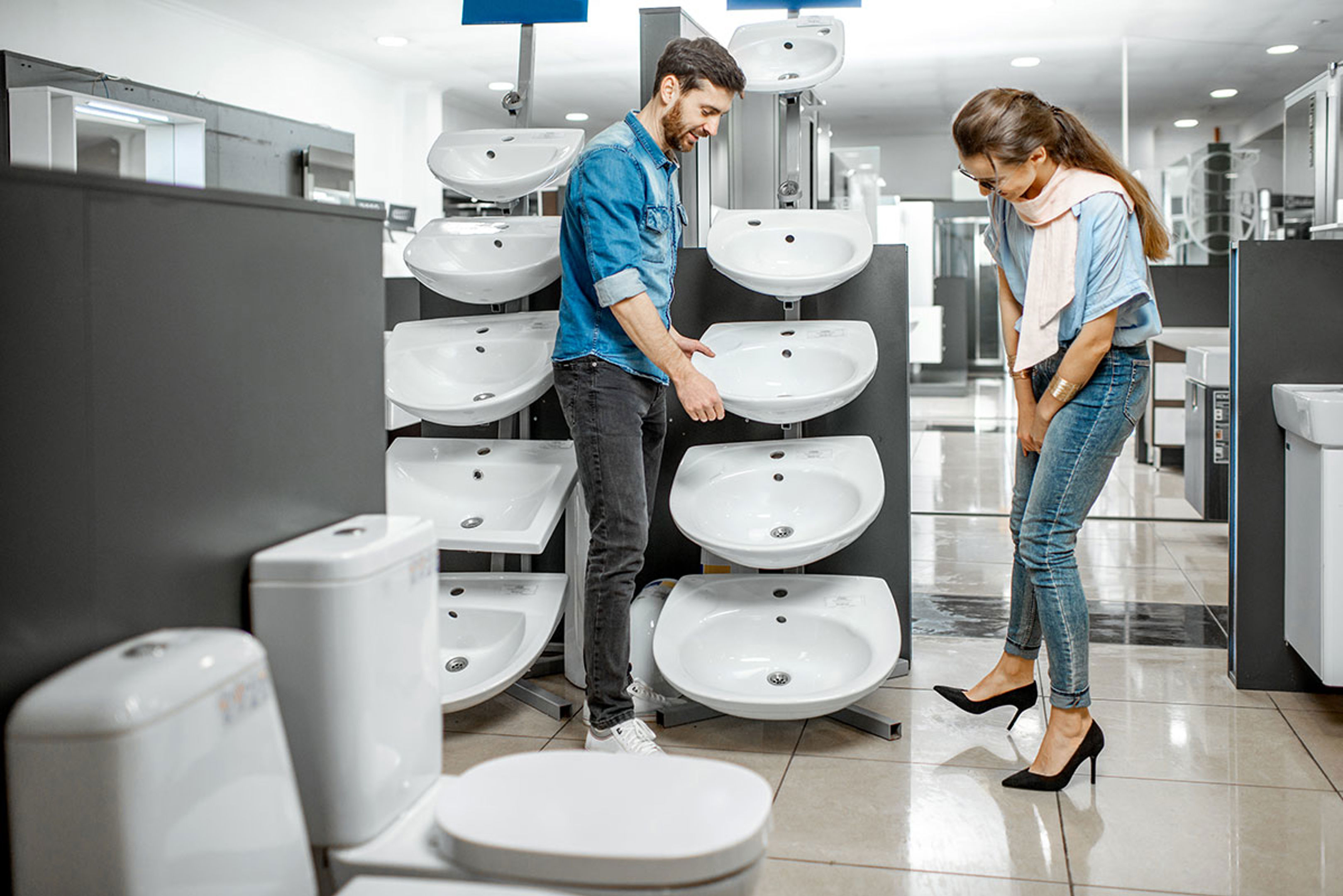How much does a new bathroom cost?
Dreaming of a new bathroom for your home? Updating your bathroom can be an expensive job, but whether you’re creating your ideal bathroom or upgrading to increase the value of your home, it can be well worth the time and money you invest in it.

So, how much does a new bathroom cost?
The average cost of a new bathroom in the UK is around £5,000 (checktrade.com). You should bear in mind that every bathroom refurbishment is different, depending on the amount of work required, new features, design and so on.
We’ll take you through the different stages of a bathroom renovation to see how you can tailor your requirements to suit your budget and home, making your dream a reality.
What influences the cost of a new bathroom?
In the first instance, the cost of a new bathroom should be influenced by how much you can afford. Once you have a rough idea of your budget, you’ll need to consider all of the different features you’d like for your new bathroom that will fit your budget and what could stretch it.
Considering your budget at the outset means you’ll know how much you have available to spend on each feature and how to divide it between what you’d like to include in your bathroom renovation.
Taking this approach will also help you to decide if you’ll be a savvy shopper, considering the cost of your products and making savings here and there, or whether you’d prefer to choose the more premium products.

Bathroom features
When you purchase your new bathroom, you’ll have a few decisions to make. You could choose a standard bathroom suite which is usually a pre-selected matching bath, basin, toilet set, and sometimes shower enclosure or bathroom furniture. This type of bathroom can often be purchased at a discounted price.
Or if you’d like to design your bathroom just the way you want it, you can purchase each of your preferred bathroom items separately:
Bath – The type of bath you choose can affect how much you spend quite significantly. Available in a range of styles and made using a variety of materials, the needs of your household and your personal style could affect how much you end up spending. The cheapest option tends to be a basic straight edge acrylic bath. If you’re hoping for freestanding baths, easy access baths, cast iron baths, and whirlpool baths these tend to be in the higher-end price range.
Toilet and Basin – Modern technology and contemporary design has led to more toilet and basin designs to choose from than ever before. A basic pedestal toilet or basin with standard fittings is likely to be the most affordable choice; with wall hung toilets, concealed cisterns, and double basin sinks likely to cost more.
Shower – Quick and convenient, adding a shower to a bathroom is a must for most homeowners. If you’re working to a tight budget, a wall mounted electric shower installed over a bath could be your cheapest option, but if you’re looking for something a little more luxurious, a separate double shower enclosure with a concealed shower set and rain showerhead will stretch your budget quite a bit further.
Furniture & Accessories – In most homes, storage space is limited. Bathroom furniture gives the opportunity to add much-needed drawers and cupboards to otherwise wasted space. A basin with an inbuilt vanity unit may cost more than a regular sink but it will help to make the most of an unused space in the bathroom. Likewise, a regular mirror would be a cheaper option, but a more expensive anti-mist or illuminated mirror could help make getting ready in the morning easier and quicker.
Tiling – The tiles and flooring in your bathroom can also vary greatly in cost. You should consider what options are best for you and your needs. Your budget for tiles will depend on your choice of material and the size of the area you intend to cover.

Labour costs
When the time comes to fit your new bathroom, you’re likely to need some help from the professionals which will increase your spend. Labour costs might include hiring:
- A plumber: A plumber will help to disconnect, redirect, and reconnect any pipework before your bathroom is fitted. Once the basin and shower are in place, a plumber will ensure the taps and controls are installed and working correctly, and that water in the bathroom drains away properly.
- An electrician: From overhead lighting to connecting an electric shower, a qualified electrician will ensure all and any electrical work is completed safely and competently. You should bear in mind that bathroom accessories like illuminated mirrors or feature lights can give your bathroom a contemporary look and feel but may require additional electrical work.
- Other tradespeople: Depending on your ability and your budget, you may need to hire other skills to complete your new bathroom. This could mean getting quotes from labourers to remove your old bathroom, plasterers to repair exposed ceilings and walls, tilers for tiling work on flooring and walls, and decorators to paint any remaining walls or painted surfaces.

How much value does a new bathroom add to your home?
Homebuyers often look for a new home that requires as little work as possible, allowing them to move in without the added expense of further renovation or refurbishment. So, viewing a house with an updated modern bathroom or en-suite can be extremely appealing.
A refurbished bathroom has the potential to add up to 5% percent of value onto a home, and can be a valuable selling point in the future.
A new bathroom is also less likely to need repair in the immediate future and should be less prone to leaking if fitted correctly. For families looking to buy a new home, finding a functional family bathroom is key, so a well thought out use of space with options for showering and bathing should also work to your advantage if you decide to sell.

Bathroom finance options
Once you decide to go ahead with a bathroom refurbishment, you’ll need to figure out the best way to pay for it all. There are several different ways you could finance your project, all depending on how much you can afford to spend and the overall size of your project. Here we look at the different options for you to consider, to help you decide how you might want to finance your next home improvement:
Personal savings
If you have some cash savings that are readily available, you could consider using your savings to pay for your new bathroom. Less expensive than some other home renovations, paying for your new bathroom with your savings can be an affordable and sensible way to avoid making repayments on credit or loans, so you won’t incur any interest or charges.
Before you access your savings, check for any release fees as this could be an extra cost for you to consider. Make sure that you can afford to use some or all of your savings, as once you start your renovations your nest egg won’t be a big as it once was.
Credit card
Using a credit card is another alternative for funding your new bathroom. A credit card can be used for a range of purchases, allowing you to pay a balance each month usually with a charge for interest. Credit card interest rates will vary from bank to bank, so it might be worth shopping around to find the lowest rate, keeping any credit expenses as low as possible.
Using a credit card can seem convenient, but you could run the risk of losing track of how much you’ve spent and how much you’ll need to repay. An outstanding balance on a credit card can quickly accumulate interest, so you’ll also need to make sure you pay off what you can regularly to reduce the amount of interest you pay overall.
Personal loan
If you’d prefer to borrow money and make repayments each month over a fixed term, then a home improvement loan could be for you. Taking out a home improvement loan could provide you with the funds you need to buy and install a new bathroom, taking your individual circumstances and eligibility criteria into account.
With a loan, as long as you make your repayments regularly, you’ll pay the same agreed amount each month until the loan is repaid in full, helping you to keep track of how much you owe without any unexpected costs.
Interest free credit
Buying a bathroom on interest free credit can be a good choice for financing your home improvement project. Depending on your credit limit, you could cover the cost of a new bathroom and pay off an interest free credit balance in affordable increments each month.
You’ll need to be sensible with your purchases, setting yourself a budget so you can afford to pay off your balance in full before the interest free term ends, to avoid growing interest rate charges on any outstanding balance.
Buy now, pay later
Buy now, pay later deals can work in your favour, however you should always check the terms and conditions before committing to an agreement. This finance option is usually used for making a large one-off purchase – so you can keep hold of your money for longer, arrange delivery or take away the products the same day, and settle your balance at a later date.
If you enter into a buy now, pay later agreement to help cover the cost of your new bathroom you’ll need to make sure you have the money to ‘pay later’. Once the grace period is over, any outstanding amount on your balance could be subject to interest rates, leaving you paying out more than you intended.
Pay monthly bathroom finance
Funding your new bathroom renovation with a pay monthly finance scheme will work similarly to other credit deals or loans. Depending on the cost of your bathroom, you’ll need to make a deposit or payment on your bathroom and then make repayments each month over an agreed period of time.
Choosing the right finance option for you can be a lot to consider.
By considering how much your bathroom renovation could cost and the budget you have available, you’ll be able to choose a bathroom that best fits you and your needs.
Article Author
For more articles from Paul, explore their author profile

Paul Went – Managing Director, Consumer Banking
Think a home improvement loan might be right for you?
Related Articles

How much does a new kitchen cost?
Maybe your cooker’s on the blink again or that cupboard door just won’t shut properly. Or perhaps you want to compare the cost of moving house to the cost of a brand new kitchen renovation? Either way, if you think it’s time for the upgrade you’ve always talked about, you’ll probably want to know what costs are likely to be included.

The biggest barriers to finishing a home improvement
To help you plan for your next project, we reveal the biggest barriers to completing DIY projects around the home according to our research.